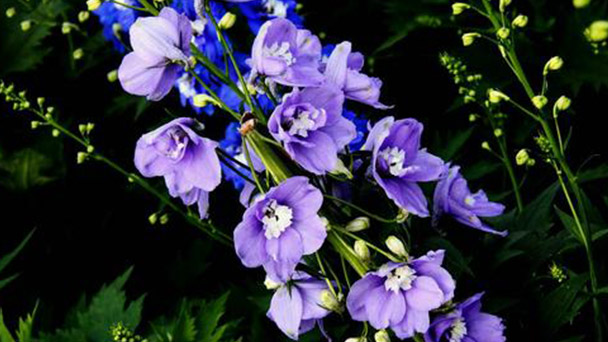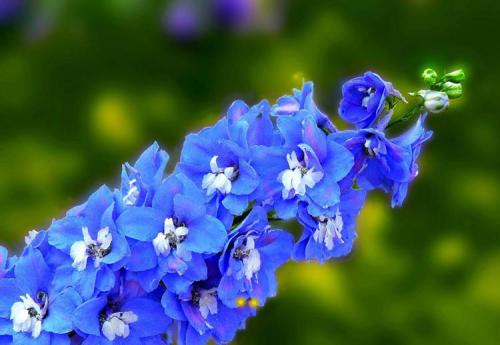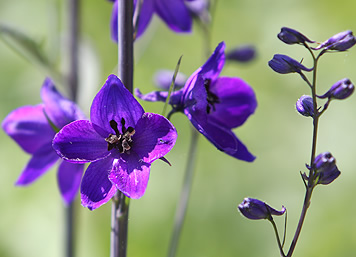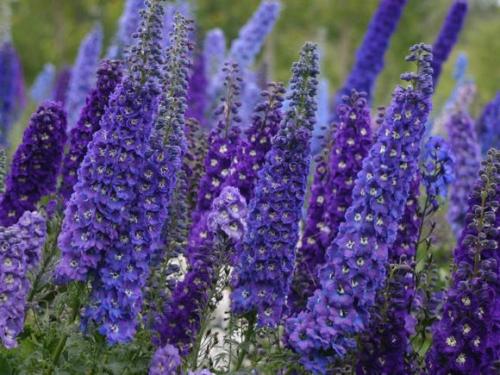Doubtful knights-spur profile
Written by Maggie
Jan 22 2021

Doubruskknight's-spur, scientific name Consolida ajacis is a perennial herb of the genus Ranunculaceae Doubruskknight's-spur. DoubrucKnight's-Spur originated in southern Europe and is cultivated in every province of China.
DoubrucKnight 's-spur picture

DoubrucKnight 's-spur morphological features
Stem branches
DoubrucKnight's-Spur is an annual herb, less than 1 m tall and slightly hairy. The branches are few and uplifted. Basal leaves are long petiolate, 3 deep lobes several to base, lobes divided into many linear fractions; Upper leaf is sessile, also with many linear lobes. DoubrucKnight 's-spur stem ca. is 60 cm tall, with inflorescences more or less curved pubescent, branched above middle.
Leaf
DoubrucKnight 's-spur stem lower leaves are long-stalked and much withered upon flowering, upper middle leaves short-stalked; Leaf blade is 3 cm long, palmately lobed, narrowly linear lobes 0.4 -- 1 mm wide, pubescent.
Flowers
DoubrucKnight's-spur inflorescence stems or branching are apically; Proximal bracts are leafy, distal bracts small, undivided, linear; Pedicels are 0.7-2.8 cm long; Bracteoles are near middle of pedicel, lobes; DoubrucKnight 's-spur sepals are purple, pink or white, broadly ovate, ca. 1.2 cm long, outer center sparsely pubescent, spur subulate, ca. 1.6 cm long; Petals are trilobed, lobes ca. 5 mm long, apex dilobed, lateral lobes at right angles to lobes, ovate; Anthers ca. is 1 mm.
DoubrucKnight's-spur even more in the filling of flowers when a flock of bluebirds fall from the sky, very appealing.
Doubruced Knight 's-Spur blooms August - September.
Fruit
Doubrucous Knight 's-spur follicles 3 clumps, follicles 1.8 cm long, straight, densely pubescent, reticulate veins slightly raised, not much obvious. Seeds are about 2 mm long.
Doubruced Knight 's-Spur fruitfulness September - October.
DoubrucKnight 's-Spur's ecological habits
DoubrucKnight's-spur wild originals are native to the Northern Hemisphere's temperate regions and prefer sunny, well-ventilated, well-drained soils that are rich in organic matter and are fertile and sandy. DoubrucKnight's-spur cold resistance, drought resistance are relatively strong, but not high temperature resistance, so in summer high temperature areas, should be moved to a cool place to cultivate.
DoubrucKnight's-spur likes cool climates, with daytime temperatures ranging from 20 ° C to 25 ° C and night temperatures ranging from 13 ° C to 15 ° C. Before flowering, a proper amount of nitrogen fertilizer should be applied, and phosphate and potash fertilizer should be applied after flowering. DoubrucKnight's-spur for cut flower cultivation DoubrucKnight's-spur for cut flower cultivation is tall, so care should be taken to prevent the plants from falling over. A net can be drawn between the plants to prevent falling over. DoubrucKnight's-spur is afraid of water, so pay attention to drainage on rainy days.
Due to the Doubtful Knight 's-spur fruit ripening inconsistency and natural opening after ripeness, the seed is easily lost, so it should be collected in time
Doubruced Knight 's-spur distribution area
DoubrucKnight's-spur is originally from China and Northwest Siberia. Altitude: 700 m. The domestication of horticulture began in the 17th century. With its tall and straight plants, delicate leaves, full inflorescences and dense flowers, DoubrucKnight's-spur has become a "pretty woman" in European gardens and has been widely used in gardens.
Currently, DoubrucKnight's-spur has been cultivated in all provinces of China, and there are even DoubrucKnight's-spur wild seeds in places such as Hebei. Under the trend of vigorously advocating the use of native flowers in landscaping and beautification, we believe that this kind of beautiful flowers will be more widely used.

DoubrucKnight's-spur growing methods
DoubrucKnight's-spur requires a sunny and cool growing environment that can withstand both cold and drought, but is not resistant to high temperatures and moisture and is not very soil demanding. However, the following problems should be paid attention to when planting:
(1) Sowing time: In spring and autumn, DoubrucKnight's-spur can be planted, if the planting in the autumn must be carried out in the middle of September.
(2) Maintenance: after sowing, the soil must be kept moist. The easiest way is to cover some grass, and gradually remove the mulch after emergence.
(3) Transplanting: When DoubrucKnight's-spur grows two true leaves, we transplant them in a small pot with soil, and change the pot again when the seedling is grown.
(4) Watering: Watering to see dry, see wet, in the flower period to be appropriate to water a little more, to avoid the soil too dry.
(5) Fertilization: in the basin when applied into dry manure as the base fertilizer, according to the growth situation, every month 1~3 times the stale cake fertilizer water.
(6) Control height: after changing the pot for DoubrucKnight's-spur, use the potpotazole to control the height of the plant, the specific practice is: every 2 weeks apply 0.5% potpotazole 1 time.
(7) Seed collection: Seed collection should be timely, so as not to mature fruit cracking.
DoubrucKnight's-spur propagation methods
DoubrucKnight's-spur can be propagated by seed or cuttage.
DoubrucKnight's-spur Sowing propagation
The suitable temperature for DoubrucKnight's-spur germination is L5 ℃, and the best temperature is below 20℃ for germination in about two weeks. Autumn sowing is from late August to early September. First, DoubrucKnight's-spur is sown into the open seedbed. Before winter, it goes into the cold bed or cold chamber for overwintering. In early spring, direct seeding was conducted on open ground in southern China, and the spacing of seedlings was 25~5 cm. In the north, seedlings of DoubrucKnight's-spur are generally raised in advance and colonized in April. Two to four true leaves are transplanted and four to seven true leaves are colonized. Pay attention to drainage on rainy days. Fruit ripening period is not consistent, when ripe when natural cracking, so should be harvested in time. Generally in June will have ripe seeds first harvested 1~2 times, in July to choose all the best harvest drying threshes. Cutting propagation of DoubrucKnight's-spur in the spring, when the new leaves grow more than 5 cm cut cuttings, inserted into the sand.
DoubrucKnight's-spur division propagation
Spring and autumn can be carried out DoubrucKnight's-spur division propagation, generally 2~3 years a plant.
DoubrucKnight's-spur main value
DoubrucKnight's-spur landscape value
DoubrucKnight's-spur has a chic design and elegant colors. Or planting, planting flower beds, flower borders, can be used as cut flowers, tall flower varieties or good materials for cut flowers.
Industrial action
DoubrucKnight's-spur whole grass is poisonous and the seed oil can be used industrially.

Latest Updated
- Benefits of Bugleweed - 7 Science-backed Health Benefits
- Bugleweed Dangers & Side Effects - Is It Poisonous?
- How to Plant Evergreen Trees - What You Should Know
- When to Plant Evergreens - Grow Guide for Evergreen Trees
- 12 Wonderful Evergreen Shrubs for Your Garden
- 12 Popular Evergreen Plants with Pictures for Beginners
- When And How To Prune A Lilac Bush Like a Pro
- How to Grow & Care for Lilac Vine (Hardenbergia Violacea)
- Japanese Lilac Tree (Syringa Reticulata) Care & Propagation Guide
- Shumard Oak Pros and Cons - What to Know
Popular Articles
- Winter maintenance of Antirrhinum Majus
- How to Grow Terminalia Mantaly Tree
- How to Grow and Care for Crossostephium Chinense
- How to grow Antirrhinum Majus in spring
- Peristeria Elata (Dove Orchid) Profile: Info & Care Guide
- Underwatered Snake Plant (Sansevieria Trifasciata) - Signs And How To Fix
- How to Care for Brazilian Jasmine Plant (Mandevilla Sanderi)
- How to Grow & Care for Graptopetalum Purple Delight in Summer
- Rosa Chinensis (China Rose): Plant Growing & Care Tips
- How to Care for Baby Sun Rose (Aptenia Cordifolia)